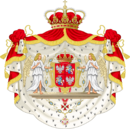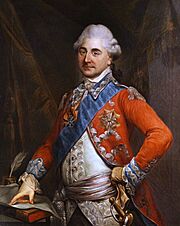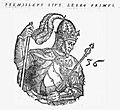List of Polish monarchs facts for kids
Quick facts for kids Monarchy of Poland |
|
|---|---|

|
|

|
|
| Details | |
| Style |
|
| First monarch |
|
| Last monarch | Stanislaus II Augustus |
| Formation | c. 960 (Duchy of Poland) |
| Abolition | 25 November 1795 |
| Residence |
|
| Appointer |
|
| Pretender(s) |
|
Poland was once led by dukes and princes, from the 900s to the 1300s. Later, it was ruled by kings, from the 1000s to the 1700s. A special thing about Poland was that its kings were often chosen by election, not just born into the role. This was very unique in Europe during the 1500s to 1700s.
The first Polish ruler we know for sure existed was Duke Mieszko I. He brought Christianity to Poland in 966. His son, Bolesław I the Brave, became the first king in 1025. He made Poland much bigger.
Over the centuries, powerful families ruled Poland. The Piast dynasty was one of the most important. They had both kings and dukes. Their rule ended in 1370 with Casimir III the Great. After him, the Capetian House of Anjou took over, with Louis I ruling both Poland and Hungary.
His daughter, Jadwiga, married Jogaila, the Grand Duke of Lithuania. He became Christian and was crowned Władysław II Jagiełło in 1386. This created the Jagiellonian dynasty and joined Poland and Lithuania.
Contents
The Jagiellonian Dynasty: A Golden Age
During the reigns of kings like Casimir IV Jagiellon and Sigismund I the Old, Poland saw a lot of growth. Culture and arts thrived, and cities became more developed. This time was known as the Polish Renaissance. It continued until the Union of Lublin under Sigismund II Augustus, which officially created the Polish–Lithuanian Commonwealth. This period is often called Poland's "Golden Age."
After the last Jagiellonian king died, the Polish–Lithuanian Commonwealth became a country where kings were elected. Often, these elected kings were from other countries.
Elected Kings and Challenges
One of the first elected kings was Henry III of France. During his short rule, the "Golden Liberty" system was introduced. This system gave a lot of power to the nobility. Stephen Báthory was another strong elected king. He was a skilled military leader who made the country stronger.
The Vasa dynasty also ruled Poland. They helped the Commonwealth grow, and arts and trade improved. However, King Sigismund III Vasa led Poland into many wars. While some wars were successful, like capturing Moscow, others led to losses, such as Livonia to Sweden. His son, Władysław IV Vasa, defended Poland's borders well. But his successor, John II Casimir, had a difficult reign and eventually gave up his throne.
Later Kings and the End of the Monarchy
The election of John III Sobieski was good for Poland. He was a brilliant military leader. In 1683, he led forces to a great victory at the Battle of Vienna against the Ottoman Empire. He even won back some land.
However, the years after John III Sobieski were not as strong for Poland. The Wettin dynasty, with kings like Augustus II the Strong and Augustus III, brought Poland under the influence of Saxony and Russia. Conflicts with Polish nobles and other countries weakened Poland's power.
The Partitions of Poland
This led to the sad time of the Partitions of Poland. During this period, neighboring countries divided Poland among themselves. This happened under King Stanislaus II Augustus. He was an educated king, but he couldn't stop the partitions.
The last ruler of a Polish state was Frederick Augustus I of Saxony, who was the Duke of Warsaw. He tried to bring Poland back to strength. After the Napoleonic Wars, the idea of a Polish monarchy ended. Poland became a republic in 1918, with a parliament leading the country.
Early Polish Rulers: The Piast Dynasty
The Piast dynasty was the first major ruling family of Poland. They ruled for centuries, starting with Duke Mieszko I.
- Mieszko I (960–992): The first known ruler of Poland. He brought Christianity to the country.
- Bolesław I the Brave (992–1025 as duke, 1025 as king): Mieszko I's son. He was the first crowned King of Poland and made the country much larger.
- Mieszko II Lambert (1025–1031 as king, 1033–1034 as duke): Crowned king, but faced challenges and was later deposed.
- Bezprym (1031–1032): Ruled a part of the country after Mieszko II was deposed.
- Casimir I the Restorer (1034/1040–1058): He helped rebuild Poland after a period of chaos.
- Bolesław II the Generous (1058–1076 as duke, 1076–1079 as king): Crowned king, but was later exiled.
- Władysław I Herman (1079–1102): Became duke after his brother was exiled.
- Bolesław III Wrymouth (1107–1138): A strong duke. His death led to Poland being divided among his sons.
Poland Divided: High Dukes (1138–1320)
After Bolesław III Wrymouth died, Poland was split into smaller parts ruled by different dukes. The "High Duke" was supposed to be the most important, ruling from Kraków.
- Władysław II the Exile (1138–1146): The first High Duke, but he was later deposed and exiled.
- Bolesław IV the Curly (1146–1173): Succeeded his half-brother.
- Mieszko III (1173–1177, 1190, 1198–1199, 1199–1202): Ruled several times, often being deposed and then returning to power.
- Casimir II the Just (1177–1190, 1190–1194): Took power from his brother.
- Leszek I the White (1194–1198, 1199, 1206–1210, 1211–1227): Ruled multiple times, but was murdered in 1227.
- Władysław III Spindleshanks (1202–1206, 1227–1229): Also took and lost power several times.
- Mieszko IV Tanglefoot (1210–1211): Ruled for a short period.
- Konrad I of Masovia (1229–1232, 1241–1243): A duke who tried to gain control of Kraków.
- Henry I the Bearded (1232–1238): A powerful duke who expanded his control.
- Henry II the Pious (1238–1241): Succeeded his father, but was killed in the Battle of Legnica.
- Bolesław V the Chaste (1243–1279): Restored as the rightful duke.
- Leszek II the Black (1279–1288): Succeeded Bolesław V.
- Henryk IV Probus (1288–1290): Ruled briefly.
Restoring the Kingdom (1295–1370)
After a long period of division, Poland began to reunite.
- Przemysł II (1290–1291 as duke, 1295–1296 as king): He was crowned king in 1295, trying to bring Poland back together. He was assassinated.
- Wenceslaus II of Bohemia (1296–1300 as High Duke, 1300–1305 as King): From Bohemia, he crowned himself King of Poland.
- Wenceslaus III of Bohemia (1305–1306): Succeeded his father, but was uncrowned and assassinated.
- Ladislaus the Short (1306–1320 as High Duke, 1320–1333 as King): He successfully reunited the Kingdom of Poland and was crowned king in 1320.
- Casimir III the Great (1333–1370): Ladislaus's son. He greatly strengthened Poland and is considered one of its greatest kings. He died without a male heir, ending the Piast dynasty.
The Anjou Dynasty
After the Piast dynasty, the Anjou family from Hungary took the Polish throne.
- Louis I (1370–1382): Succeeded his uncle, Casimir III. He was also King of Hungary.
- Hedwig (1384–1399): Louis's daughter. She became Queen of Poland and married Jogaila, who became King Władysław II Jagiełło.
The Jagiellonian Dynasty
This dynasty began with the marriage of Queen Jadwiga and Grand Duke Jogaila, uniting Poland and Lithuania.
- Władysław II Jagiełło (1386–1434): Born a pagan, he became Christian and was crowned co-ruler with his wife, Jadwiga. He was the longest-reigning Polish monarch.
- Władysław III (1434–1444): Succeeded his father. He was also King of Hungary. He was killed in battle at a young age.
- Casimir IV (1447–1492): Succeeded his brother. He was also Grand Duke of Lithuania.
- John I Albert (1492–1501): Succeeded his father. He helped set up the Polish Parliament (Sejm and Senate).
- Alexander (1501–1506): Succeeded his brother. He was also Grand Duke of Lithuania.
- Sigismund I the Old (1506–1548): Succeeded his brother. His reign saw a flourishing of culture.
- Sigismund II Augustus (1548–1572): Succeeded his father. He created the Polish–Lithuanian Commonwealth, which became an elective monarchy. He was the last male member of the Jagiellonian Dynasty.
Polish–Lithuanian Commonwealth: Elected Kings (1569–1795)
After the Jagiellonian dynasty ended, kings were elected by the Polish nobility.
- Henry (1573–1575): Elected king, but left Poland to become King of France.
- Anna (1575–1596): Elected Queen, often ruling with her husband or after his death.
- Stephen Báthory (1576–1586): Elected co-monarch with Anna. He was a skilled military leader.
- Sigismund III (1587–1632): Elected king, nephew of Anna Jagiellon. He moved the capital from Kraków to Warsaw.
- Władysław IV (1632–1648): Elected king, son of Sigismund III. He was also a strong military leader.
- John II Casimir (1648–1668): Elected king, half-brother of Władysław IV. He later gave up his throne.
- Michael I (1669–1673): Elected king.
- John III Sobieski (1674–1696): Elected king. A famous military commander who won the Battle of Vienna.
- Augustus II (1697–1706, 1709–1733): Elected king from Saxony. He was dethroned for a time during a war.
- Stanislaus I (1704–1709, 1733–1736): Elected king, but his rule was often challenged. He was exiled and later deposed again.
- Augustus III (1733–1763): Became king after a war over who should rule.
- Stanislaus II Augustus (1764–1795): The last King of Poland. His reign ended with the partitions of Poland by neighboring countries.
Duchy of Warsaw (1807–1815)
After the partitions, a small Polish state called the Duchy of Warsaw was created by Napoleon.
- Frederick Augustus I (1807–1815): He was the Duke of Warsaw. He tried to bring back the Polish state.
Images for kids




















